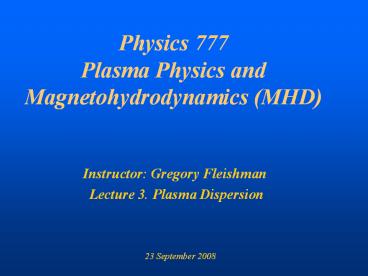Physics 777 Plasma Physics and Magnetohydrodynamics (MHD) - PowerPoint PPT Presentation
Title:
Physics 777 Plasma Physics and Magnetohydrodynamics (MHD)
Description:
Physics 777. Plasma Physics and Magnetohydrodynamics (MHD) Instructor: Gregory Fleishman ... (including nonlinear plasma current in a general case) ... – PowerPoint PPT presentation
Number of Views:81
Avg rating:3.0/5.0
Title: Physics 777 Plasma Physics and Magnetohydrodynamics (MHD)
1
Physics 777Plasma Physics and Magnetohydrodynamic
s (MHD)
- Instructor Gregory Fleishman
- Lecture 3. Plasma Dispersion
23 September 2008
2
Plan of the Lecture
- Macroscopic Maxwell Equations. Linear response
- Eigen-modes of anisotropic and Gyrotropic media
General Case - Cold Plasma Approximation
- Multi-Component Plasma
- Maxwellian plasma
- Collisional and Collisionless Plasma
- MHD approximation
3
Section 1. Macroscopic Maxwell Equations. Linear
response
Introduce polarization vector continuity Eqn. is
fulfilled
Form displacement vector DE4pP the most
general (non-local) linear relation for
statistically uniform medium reads
4
Section 1. Macroscopic Maxwell Equations. Linear
response
Make the Fourier transform
where
Excluding the magnetic field from Maxwell
equations we obtain For the E Fourier component
5
A convenient, more compact form
where
is the Maxwellian tensor, j is an external
electric current (including nonlinear plasma
current in a general case).
Note for any medium without dissipation the
dielectric tensor is Hermitian (and vice
versa). If the dielectric tensor is Hermitian,
the Maxwellian tensor is Hermitian too.
6
Section 2. Eigen-modes of anisotropic and
Gyrotropic media General Case
Normalized polarization vector
- Principal values
- Refractive index
7
The dispersion relations are found from equating
the determinant to zero
where
Thus, if spatial dispersion is insignificant, the
dispersion relations can be calculated as a
solution of quadratic equation for any medium
Note, that Hermitian (e.g., Maxwellian) tensor
can be transformed to a diagonal form with real
eigen-values on the basis of orthogonal complex
eigen-vectors, i.e.
8
In components
9
Section 3. Cold plasma approximation.
Subsection 3.1. Isotropic plasma
Subsection 3.2. Magnetized plasma
10
Section 4. Multi-component plasma
As we had for the isotropic plasma, we can write
Take into account both electron and ion
contributions
If there are many specious of ions in the plasma,
then each of them will contribute into the
dielectric tensor components. The contributions
of the heavier ions are especially important
around corresponding gyroresonance. Another
important example of the multi-component plasma
is a plasma composed of normal (cold) component
and high-energy (warm/hot) component, which will
be studied later.
11
Section 5. Maxwellian plasma
Fourier
?
12
Subsection 5.1. Isotropic Maxwellian plasma
Taking into account both electron and ion
contribution we obtain
Calculate this approximately for the cases of
small and large arguments of F
13
Subsection 5.2. Magnetized Maxwellian plasma
where
14
Section 6. Collisional and collisionless plasma
(f0-f)/t
15
Section 7. MHD approximation
16
Fourier transform yields
17
Section 8. Homework
- 1. Check and correct the homework from Lecture 1.
- 2. Calculate the plasma permeability
approximately for the cases of small and large
arguments of F (see Sec. 5)
















![L 34 Modern Physics [1] PowerPoint PPT Presentation](https://s3.amazonaws.com/images.powershow.com/7125701.th0.jpg?_=20150905079)
![L 33 Modern Physics [1] PowerPoint PPT Presentation](https://s3.amazonaws.com/images.powershow.com/7602675.th0.jpg?_=201602121011)













